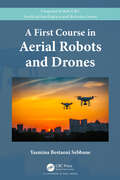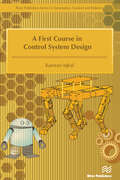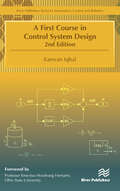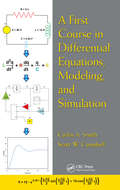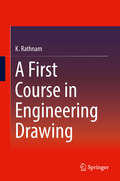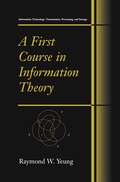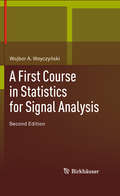- Table View
- List View
A First Course in Aerial Robots and Drones (Chapman & Hall/CRC Artificial Intelligence and Robotics Series)
by Yasmina Bestaoui SebbaneA First Course in Aerial Robots and Drones provides an accessible and student friendly introduction to aerial robots and drones. Drones figure prominently as opportunities for students to learn various aspects of aerospace engineering and design. Drones offer an enticing entry point for STEM studies. As the use of drones in STEM studies grows, there is an emerging generation of drone pilots who are not just good at flying, but experts in specific niches, such as mapping or thermography. Key Features: Focuses on algorithms that are currently used to solve diverse problems. Enables students to solve problems and improve their science skills. Introduces difficult concepts with simple, accessible examples. Suitable for undergraduate students, this textbook provides students and other readers with methods for solving problems and improving their science skills.
A First Course in Aerial Robots and Drones (Chapman & Hall/CRC Artificial Intelligence and Robotics Series)
by Yasmina Bestaoui SebbaneA First Course in Aerial Robots and Drones provides an accessible and student friendly introduction to aerial robots and drones. Drones figure prominently as opportunities for students to learn various aspects of aerospace engineering and design. Drones offer an enticing entry point for STEM studies. As the use of drones in STEM studies grows, there is an emerging generation of drone pilots who are not just good at flying, but experts in specific niches, such as mapping or thermography. Key Features: Focuses on algorithms that are currently used to solve diverse problems. Enables students to solve problems and improve their science skills. Introduces difficult concepts with simple, accessible examples. Suitable for undergraduate students, this textbook provides students and other readers with methods for solving problems and improving their science skills.
A First Course in Applied Electronics: An Introduction to Microelectronic Systems (PDF)
by William GoslingFirst Course in Applied Electronics An Introduction to Microelectronic Systems
A First Course in Boundary Element Methods (Mathematical Engineering)
by Steven L. Crouch Sofia G. MogilevskayaThis textbook delves into the theory and practical application of boundary integral equation techniques, focusing on their numerical solution for boundary value problems within potential theory and linear elasticity. Drawing parallels between single and double layer potentials in potential theory and their counterparts in elasticity, the book introduces various numerical procedures, namely boundary element methods, where unknown quantities reside on the boundaries of the region of interest. Through the approximation of boundary value problems into systems of algebraic equations, solvable by standard numerical methods, the text elucidates both indirect and direct approaches. Indirect methods involve single or double layer potentials separately while direct methods combine these potentials using Green's or Somigliana's formulas. The two approaches give comparable results for general boundary value problems. Tailored for beginning graduate students, this self-contained textbook offers detailed analytical and numerical derivations for isotropic and anisotropic materials, prioritizing simplicity in presentation while progressively advancing towards more intricate mathematical concepts, particularly focusing on two-dimensional problems within potential theory and linear elasticity.
A First Course in Control System Design (River Publishers Series In Automation, Control And Robotics Ser.)
by Kamran IqbalControl systems are pervasive in our lives. Our homes have environmental controls. The appliances we use at home, such as the washing machine, microwave, etc. have embedded controllers. We fly in airplanes and drive automobiles, which make extensive use of control systems. The increasing automation in the past few decades has increased our reliance on control systems.A First Course in Control System Design discusses control systems design from a model-based perspective as applicable to single-input single-output systems. The emphasis in this book is on understanding and applying the techniques that enable the design of effective control systems. The book covers the time-domain and the frequency-domain design methods, as well as the design of continuous-time and discrete-time systems.Technical topics discussed in the book include: Modeling of physical systems Analysis of transfer function and state variable models Control system design via root locus Control system design in the state-space Control design of sampled-data systems Compensator design via frequency response modification
A First Course in Control System Design
by Kamran IqbalControl systems are pervasive in our lives. Our homes have environmental controls. The appliances we use at home, such as the washing machine, microwave, etc. have embedded controllers. We fly in airplanes and drive automobiles, which make extensive use of control systems. The increasing automation in the past few decades has increased our reliance on control systems.A First Course in Control System Design discusses control systems design from a model-based perspective as applicable to single-input single-output systems. The emphasis in this book is on understanding and applying the techniques that enable the design of effective control systems. The book covers the time-domain and the frequency-domain design methods, as well as the design of continuous-time and discrete-time systems.Technical topics discussed in the book include: Modeling of physical systems Analysis of transfer function and state variable models Control system design via root locus Control system design in the state-space Control design of sampled-data systems Compensator design via frequency response modification
A First Course in Control System Design
by Kamran IqbalControl systems are pervasive in our lives. Our homes have environmental controls. The appliances we use, such as the washing machine, microwave, etc. carry embedded controllers in them. We fly in airplanes and drive automobiles that extensively use control systems. The industrial plants that produce consumer goods run on process control systems. The recent drive toward automation has increased our reliance on control systems technology.This book discusses control systems design from a model-based perspective for dynamic system models of single-input single-output type. The emphasis in this book is on understanding and applying the techniques that enable the design of effective control systems in multiple engineering disciplines. The book covers both time-domain and the frequency-domain design methods, as well as controller design for both continuous-time and discrete-time systems. MATLAB© and its Control Systems Toolbox are extensively used for design.
A First Course in Control System Design
by Kamran IqbalControl systems are pervasive in our lives. Our homes have environmental controls. The appliances we use, such as the washing machine, microwave, etc. carry embedded controllers in them. We fly in airplanes and drive automobiles that extensively use control systems. The industrial plants that produce consumer goods run on process control systems. The recent drive toward automation has increased our reliance on control systems technology.This book discusses control systems design from a model-based perspective for dynamic system models of single-input single-output type. The emphasis in this book is on understanding and applying the techniques that enable the design of effective control systems in multiple engineering disciplines. The book covers both time-domain and the frequency-domain design methods, as well as controller design for both continuous-time and discrete-time systems. MATLAB© and its Control Systems Toolbox are extensively used for design.
A First Course in Differential Equations, Modeling, and Simulation
by Carlos A. SmithEmphasizing a practical approach for engineers and scientists, A First Course in Differential Equations, Modeling, and Simulation avoids overly theoretical explanations and shows readers how differential equations arise from applying basic physical principles and experimental observations to engineering systems. It also covers classical methods for
A First Course in Differential Equations, Modeling, and Simulation
by Carlos A. Smith Scott W. CampbellA First Course in Differential Equations, Modeling, and Simulation shows how differential equations arise from applying basic physical principles and experimental observations to engineering systems. Avoiding overly theoretical explanations, the textbook also discusses classical and Laplace transform methods for obtaining the analytical solution of
A First Course in Engineering Drawing
by K. RathnamThe primary objective of this book is to provide an easy approach to the basic principles of Engineering Drawing, which is one of the core subjects for undergraduate students in all branches of engineering. Further, it offers comprehensive coverage of topics required for a first course in this subject, based on the author’s years of experience in teaching this subject.Emphasis is placed on the precise and logical presentation of the concepts and principles that are essential to understanding the subject. The methods presented help students to grasp the fundamentals more easily. In addition, the book highlights essential problem-solving strategies and features both solved examples and multiple-choice questions to test their comprehension.
A First Course in Information Theory (Information Technology: Transmission, Processing and Storage)
by Raymond W. YeungThis book provides an up-to-date introduction to information theory. In addition to the classical topics discussed, it provides the first comprehensive treatment of the theory of I-Measure, network coding theory, Shannon and non-Shannon type information inequalities, and a relation between entropy and group theory. ITIP, a software package for proving information inequalities, is also included. With a large number of examples, illustrations, and original problems, this book is excellent as a textbook or reference book for a senior or graduate level course on the subject, as well as a reference for researchers in related fields.
A First Course in Predictive Control, Second Edition (Control Series)
by J. A. RossiterThe book presents a significant expansion in depth and breadth of the previous edition. It includes substantially more numerical illustrations and copious supporting MATLAB code that the reader can use to replicate illustrations or build his or her own. The code is deliberately written to be as simple as possible and easy to edit. The book is an excellent starting point for any researcher to gain a solid grounding in MPC concepts and algorithms before moving into application or more advanced research topics. Sample problems for readers are embedded throughout the chapters, and in-text questions are designed for readers to demonstrate an understanding of concepts through numerical simulation.
A First Course in Predictive Control, Second Edition (Control Series)
by J. A. RossiterThe book presents a significant expansion in depth and breadth of the previous edition. It includes substantially more numerical illustrations and copious supporting MATLAB code that the reader can use to replicate illustrations or build his or her own. The code is deliberately written to be as simple as possible and easy to edit. The book is an excellent starting point for any researcher to gain a solid grounding in MPC concepts and algorithms before moving into application or more advanced research topics. Sample problems for readers are embedded throughout the chapters, and in-text questions are designed for readers to demonstrate an understanding of concepts through numerical simulation.
A First Course in Quality Engineering: Integrating Statistical and Management Methods of Quality, Third Edition
by K. S. Krishnamoorthi V. Ram Krishnamoorthi Arunkumar PennathurThe third edition of this textbook improves on the strengths of the earlier editions both in content and presentation. Of the important features of the textbook is the inclusion of examples from real-world to illustrate use of quality methods in problem solving. A thorough revision is made of the text to make all chapters suitable for self-study as well.
A First Course in Quality Engineering: Integrating Statistical and Management Methods of Quality, Third Edition
by K. S. Krishnamoorthi V. Ram Krishnamoorthi Arunkumar PennathurThis book is the leader among the new generation of text books on quality that follow the systems approach to creating quality in products and services; the earlier generations focused solely on parts of the system such as statistical methods, process control, and management philosophy. It follows the premise that the body of knowledge and tools documented by quality professionals and researchers, when employed in designing, creating and delivering the product will lead to product quality, customer satisfaction and reduced waste. The tools employed at the different stages of the product creation cycle are covered in this book using real world examples along with their theoretical bases, strengths and weaknesses. This textbook can be used for training - from shop floor personnel to college majors in business and engineering to practicing professionals. Graduate students training as researchers in the quality field will also find useful material. The book has been used as the text for a Professional Series Massive Open Online Course offered by the Technical University of Munich on edX.org, through which tens of thousands of participants from all over the world have received training in quality methods. According to Professor Dr. Holly Ott, who chose the book for the course, the text is one of the main factors contributing to success of this MOOC. The Third Edition has been fully revised to be friendly for self-study, reflects changes in the standards referenced such as ISO 9000, and includes new examples of application of statistical tools in health care industry. Features: Reviews the history of quality movement in the U.S. and abroad Discusses Quality Cost analysis and quality’s impact on a company’s bottom line Explains finding customer needs and designing the product using House of Quality Covers selection of product parameters using DOE and reliability principles Includes control charts to control processes to make the product right-the-first-time Describes use of capability indices Cp and Cpk to meet customer needs Presents problem solving methodology and tools for continuous improvement Offers ISO 9000, Baldrige and Six Sigma as templates for creating a quality system
A First Course in Statistics for Signal Analysis
by Wojbor A. WoyczynskiThis self-contained, deliberately compact, and user-friendly book is designed for a first, one-semester course in statistical signal analysis for a broad audience of students in engineering and the physical sciences. The emphasis throughout is on fundamental concepts and relationships in the statistical theory of stationary random signals, explained in a concise, yet fairly rigorous presentation. Developed by the author over the course of several years of classroom use, this book may be used by junior/senior undergraduates or graduate students in electrical, systems, computer, and biomedical engineering, as well as the physical sciences.
A First Course in Statistics for Signal Analysis
by Wojbor A. WoyczynskiThis self-contained and user-friendly textbook is designed for a first, one-semester course in statistical signal analysis for a broad audience of students in engineering and the physical sciences. The emphasis throughout is on fundamental concepts and relationships in the statistical theory of stationary random signals, which are explained in a concise, yet rigorous presentation. With abundant practice exercises and thorough explanations, A First Course in Statistics for Signal Analysis is an excellent tool for both teaching students and training laboratory scientists and engineers. Improvements in the second edition include considerably expanded sections, enhanced precision, and more illustrative figures.
A First Course in Statistics for Signal Analysis (Statistics for Industry, Technology, and Engineering)
by Wojbor A. WoyczyńskiThis self-contained and user-friendly textbook is designed for a first, one-semester course in statistical signal analysis for a broad audience of students in engineering and the physical sciences. The emphasis throughout is on fundamental concepts and relationships in the statistical theory of stationary random signals, which are explained in a concise, yet rigorous presentation. With abundant practice exercises and thorough explanations, A First Course in Statistics for Signal Analysis is an excellent tool for both teaching students and training laboratory scientists and engineers. Improvements in the second edition include considerably expanded sections, enhanced precision, and more illustrative figures.
First Course on Fuzzy Theory and Applications (Advances in Intelligent and Soft Computing #27)
by Kwang Hyung LeeFuzzy theory has become a subject that generates much interest among the courses for graduate students. However, it was not easy to find a suitable textbook to use in the introductory course and to recommend to the students who want to self-study. The main purpose of this book is just to meet that need. The author has given lectures on the fuzzy theory and its applications for ten years and continuously developed lecture notes on the subject. This book is a publication of the modification and summary of the lecture notes. The fundamental idea of the book is to provide basic and concrete concepts of the fuzzy theory and its applications, and thus the author focused on easy illustrations of the basic concepts. There are numerous examples and figures to help readers to understand and also added exercises at the end of each chapter. This book consists of two parts: a theory part and an application part. The first part (theory part) includes chapters from 1 to 8. Chapters 1 and 2 introduce basic concepts of fuzzy sets and operations, and Chapters 3 and 4 deal with the multi-dimensional fuzzy sets. Chapters 5 and 6 are extensions of the fuzzy theory to the number and function, and Chapters 7 and 8 are developments of fuzzy properties on the probability and logic theories.
First Differential Measurements of tZq Production and Luminosity Determination Using Z Boson Rates at the LHC (Springer Theses)
by David WalterThis thesis describes two groundbreaking measurements in the precision frontier at the LHC: the first ever differential measurement of the Z-associated single top quark (tZq) production, and the luminosity measurement using Z boson production rate for the first time in CMS. Observed only in 2018, the tZq process is of great importance in probing top quark electroweak couplings. These couplings are natural places for new phenomena to happen in the top quark sector of the standard model. Yet, they are the least explored directly. One has to obtain a firm understanding of the modeling of sensitive distributions to new top-Z interactions. The present analysis marks a major milestone in this long-term effort. All distributions relevant for new phenomena, and/or modeling of tZq, are studied in full depth using advanced Machine Learning techniques.The luminosity and its uncertainty contributes to every physics result of the experiment. The method minutely developed in this thesis provides a complementary measurement that results in a significant overall reduction of uncertainties.
First E.C. Conference on Solar Heating: Proceedings of the International Conference held at Amsterdam, April 30-May 4, 1984
by C. Den OudenContributors to this Conference have shown the wide range of active and passive solar heating systems which have been researched, installed and monitored in recent years throughout western Europe and elsewhere. Yet much remains to be done if solar heating is to reach its full potential. The Conference Committee hopes that this record of the proceedings will provide a basis for the further development of these systems. Many difficulties have been surmounted in arriving at today's position. The foundations of the growing confidence of architects and engineers are to be found in the concerted programmes of research and development mounted by ty,'o of the sponsors of the Conference the European Community and the International Energy Agency. Some of the more tangible products of these programmes have been reported here: component and system behaviour has been subjected to rigorous scientific study; new test facilities have been founded; test procedures devised; simulation methods developed and evaluated; design rules formulated and checked against measured performance. It has been apparent here that the willingness to exchange information and experiences, which has always been a feature of the solar energy scene, remains as strong as ever. A further information-sharing initiative was noted on the part of another sponsor, UNESCO - the setting-up of the European Cooperative Network on Solar Energy, involving countries from both eastern and western Europe.
First European Biomedical Engineering Conference for Young Investigators: ENCY2015, Budapest, May 28 - 30, 2015 (IFMBE Proceedings #50)
by Ákos JobbágyThis volume presents the proceedings of the first European Biomedical Engineering Conference for Young Investigators ENCY2015. It was in Budapest, from 28th to 30th May, 2015. The papers were assembled under the motto "Understanding complex living systems” and cover the topics sensors, image processing, bioinformatics, biomechanics, and modeling.
The First European Seminar on Computerised Axial Tomography in Clinical Practice
by G. H. DuBoulay I. F. MoseleyThe publication of proceedings of conferences has often been so delayed that they are useless both to active workers in the field and for cur rently appropriate teaching. Rapid publication on the other hand may impose very difficult conditions upon authors and demand unwelcome sacrifices. We wish to thank the many speakers at ESCAT for their co operation in providing manuscripts and to apologise to those unable for reasons beyond their control to fall in with the rigorous editorial policy. To get this book out at the earliest possible moment we have also cut the normal consultation between editors and authors to a minimum. One decision made in the interests of uniformity was to re place the various terms used by different writers by one, C. A. T. , consistent with the title of the Seminar of which the book is arecord. The organisers of ESCAT decided upon a largely didactic meeting with as little overlap as was practicable between contributions and a de termined attempt to view computerised axial tomography in the light of its clinical usefulness. As consequence, the purpose of this book is to provide a comprehensive introduction to the whole field for clin icians as weIl as radiologists. The editors wish to acknowledge the very efficient help and encourage ment of the publishers and the hard secretarial work of Miss G. JOHNS, as weIl as the editorial assistance of Dr. DEREK KINGSLEY. London, Spring 1977 G. H. DU BOULAY . I. F.
First Fuel: India's Energy Efficiency Journey and a Radical Vision for Sustainability
by Padu Padmanabhan‘A vital read’ Saurabh Kumar, Executive Vice Chairman, Energy Efficiency Services Ltd Group‘Authoritative’ Arunabha Ghosh, CEO, Council on Energy, Environment and Water, India‘A must-read’ Ashok Sarkar, Senior energy specialist, World BankThe historic oil crisis of 1973, which permanently altered significant economic policies worldwide, marked a turning point in India’s energy odyssey, putting the country on the path towards energy efficiency. A young energy researcher at the National Productivity Council at the time, Padu Padmanabhan soon found himself at a juncture that would lead him to the many watershed moments of this journey.Drawing on his extensive subsequent experience at the United States Agency for International Development in India and the World Bank, Padu takes us from the Nehruvian years of idealism, through the five-decade-long quest for fuel efficiency and energy conservation that ultimately paved the way for the shift towards energy-efficient practices. Simple yet highly effective, energy efficiency has come to be known as our first fuel – an inexhaustible source of energy that may be one of the most viable means of combating the consequences of climate change and the indiscriminate use of natural resources. Through lessons gleaned from the implementation of past energy-efficient technology, Padu shows us how this ‘fuel’ can be harnessed for a sustainable future.First Fuel is an invaluable account for not only energy-sector professionals but anyone interested in understanding what it takes to achieve energy efficiency and why we need to urgently adopt such practices. It recommends vital policy and regulatory changes and, in so doing, presents a radical new vision for energy and all its users living in the most critical of times.
